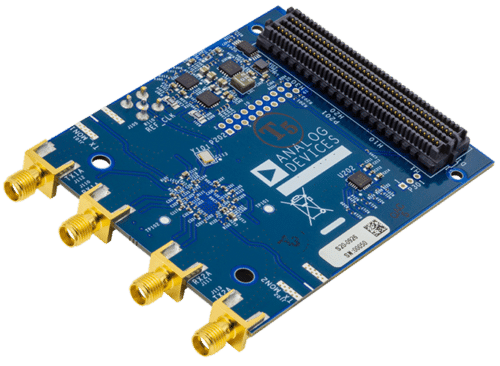The module is designed for RF applications, featuring programmability and a frequency range of 70 MHz to 6 GHz, suitable for 3G, 4G, and software-defined radios.

The AD-FMCOMMS3-EBZ is an advanced analogue module reference design from Analog Devices (ADI) that highlights the capabilities of the AD9361, a high-performance RF transceiver suitable for RF applications such as 3G and 4G base stations, test equipment, and software-defined radios. It features wideband flexibility and is programmable, making it ideal for various transceiver applications. Integrating an RF front end, a flexible mixed-signal baseband section and frequency synthesizers provide a configurable digital interface to a processor or FPGA.
Operating across a frequency range of 70 MHz to 6 GHz, the AD9361 covers most licensed and unlicensed bands. It supports channel bandwidths ranging from under 200 kHz to 56 MHz, which can be adjusted by modifying the sample rate, digital filters, and decimation settings—all programmable directly within the chip.
The evaluation board is designed for software developers and system architects who require a platform that operates over a wider tuning range than its predecessor. While it meets the datasheet specifications at 2.4 GHz, its performance across the full supported RF tuning range can vary. The board includes performance data for the entire range (70 MHz—6 GHz) to aid in system testing and waveform development.
This board primarily aims to facilitate system investigation and software teams’ initial testing of various waveforms before the finalization of custom hardware. The focus here is on practical functionality and observation of waveforms rather than optimizing the last 1dB or 1% EVM of performance. Those seeking more performance-oriented platforms may consider this reference design.
Distinguished from the AD-FMCOMMS2-EBZ’s use of the TCM1-63AX+ RF transformer from Mini-Circuits, the AD-FMCOMMS3-EBZ is better suited for applications requiring a broader tuning range. It is informally known as the “Software Engineers’” platform, highlighting its utility for extensive frequency coverage and initial development stages, as opposed to the “RF Engineers’” platform offered by the AD-FMCOMMS2-EBZ. Comprehensive design resources and software support for this board are available online through the ADI website.
The software is tunable across a broad frequency range from 70 MHz to 6.0 GHz and supports channel bandwidths ranging from less than 200 kHz to 56 MHz. It features phase and frequency synchronization on transmit and receive paths, enabling high channel density. A single FMC connector powers the system and supports MIMO radio, achieving less than 1 sample synchronization on ADC and DAC. Additionally, it includes comprehensive design resources such as schematics, layout, BOM, HDL, Linux drivers, and application software. The platform also supports add-on cards for spectrum-specific designs, including power amplifiers (PA) and low noise amplifiers (LNA).
ADI has tested this reference design. It comes with a bill of materials (BOM), schematics, assembly drawing, printed circuit board (PCB) layout, and more. The company’s website has additional data about the reference design. To read more about this reference design, click here.







Promising. I read of RFNM boards on crowdfunding websites. (Google). This is good except same price range which is bad for me. Even if it comes down, like Aerogel prices, anyone should search Russian Short Wave messages with countdowns. Spooky as hell. YT it anyway.